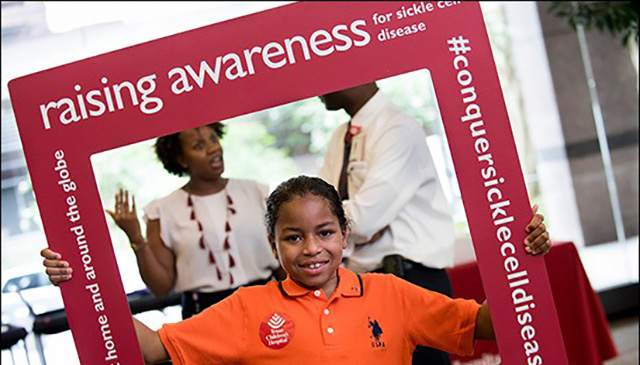
Sickle cell disease affects more than 100,000 Americans and millions more worldwide. This red blood cell disorder can be treated, but a widely available cure has yet to be found. Texas Children’s hematologist and Assistant Professor of Pediatrics Dr. Vivien Sheehan has recently developed a new sickle cell treatment based on her laboratory research. Sheehan has found that metformin, a commonly used medication for diabetes, has the ability to induce fetal hemoglobin in developing red blood cells.
Since higher levels of fetal hemoglobin reduce sickling in red blood cells of patients with sickle cell disease, the medication could potentially be useful in reducing the severity of sickle cell complications in patients. It also can be taken with another drug that increases fetal hemoglobin, hydroxyurea, to get even more clinical benefit.
Sheehan has been a part of Texas Children’s Cancer Center faculty since 2012, working tirelessly toward advancing sickle cell treatments. During a cancer related conference she attended, it was mentioned that the drug metformin could help with cancer by increasing amounts of proteins that her research showed increased fetal hemoglobin. This led Sheehan to wonder if the drug would increase fetal hemoglobin in cells from patients with sickle cell disease, and sure enough, it did.
“Because metformin is so well studied, so safe, there are millions of people literally taking it,” Sheehan said. “I then went to my Institutional Review Board (IRB) and asked if I could start a clinical trial of metformin in sickle cell patients since it was known to be safe, and wouldn’t cause hypoglycemia even in non-diabetics.”
With funding from Pfizer, in 2016 Sheehan and other researchers were able to launch a clinical trial that is currently assessing the effectiveness of metformin to make fetal hemoglobin in patients with sickle cell cared for here at Texas Children’s Hospital Hematology Center. Pfizer is a world leader in global medical advancement that provides medical research grants and scholarships for new drug development and the latest in cutting edge technology and applications. This not only led to developing the clinical trial, but also led to other acknowledgements and funding such as Sheehan’s Best of ASH recognition, given by the American Society of Hematology at the 2016 annual meeting.
“Her passion truly exudes from her and so a lot of times when you get into conversation with her, you always leave so much more educated because she’s letting you know the newest things that she has learned,” said nurse practitioner Precious Uwaezuoke. “She’s letting you know how her research studies are going. Thus, hearing her speak is always so rewarding and fun. I truly have this huge respect for her just because of how passionate she is about Sickle Cell Disease and our kids.”
Uwaezuoke works closely with Sheehan and the research team, as well as patients, and is responsible for helping to determine who may be good candidates for clinical trials. Fighting sickle cell herself, she knows that at times handling the disease can be very difficult; so she verses how important research is to getting closer to finding a cure for the disease.
“This is a big deal because having sickle cell is not easy. It affects way too many people for us to only have developed one therapy 20 years ago,” Uwaezuoke said. “To be able to see something come to fruition like this because somebody had a dream, and chased it and didn’t let it fall to the wayside is exciting. Anytime somebody wins after trying a therapy and it actually helps them, I feel like I won as well.”
Following the clinical trial, the next step will be commercialization. Sheehan says that the progress is very exhilarating and that it is amazing for a process of this magnitude to have been executed in just four years.
“Usually it takes around 15 years,” Sheehan said. “That’s the average time it takes to develop a drug from the bench to the bedside, and that’s a pharmaceutical company with all of their staff. So now we’re in 2018, we’re almost done with the first arm of our clinical trial, patients taking both hydroxyurea and metformin, and can now analyze and publish our results.”
Overall, preliminary research results show fetal hemoglobin induction, the repair of blood vessels, which is so important to help prevent complications of stroke, retinopathy, renal failure, and the other issues that cause a lot of damage or even death to some patients with sickle cell disease.
“Ultimately, I needed to determine whether patients were having more pain crises or less pain crises on metformin and whether they’re needing more transfusions or fewer transfusions”, Sheehan said. “So I compared the time period before they started the drug to the time period on metformin and they were having fewer pain crises and they were needing fewer transfusions.”
Sheehan says that research is key to improving the use of the tools that we already have. She is now looking for a few more participants to complete the second arm of the clinical trial, patients not on hydroxyurea, and also add adult patients up to the age of 40 years. Sheehan has formed a collaboration with University of Texas Health Sciences Center’s Comprehensive Sickle Cell Center and Dr. Juneja and Dr. Idowu to be able to enroll these patients.
“It’s the only way to advance in a meaningful way. You can make incremental advances just by improving access to care or use of the drug, but you’re not going to make a big, significant change without research. Those with Sickle Cell are doing better through childhood, but they’re still not living longer in adulthood and I think it’s the lack of therapies that will continue to work in our older patients and I feel like this is going to be one of them and I want to see it improve life spans and not just number of years, but health.”

